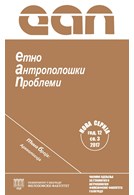Studije tehnologije i studije materijalne kulture: mogućnosti bliže saradnje na primeru koštanih artefakata
Technology Studies and Material Culture Studies: Possibilities of cooperation in the case of bone artefacts
Author(s): Selena Vitezović, Ivan VranićSubject(s): Archaeology
Published by: Филозофски факултет, Универзитет у Београду
Keywords: bone industry; technology studies; material culture studies
Summary/Abstract: Bone artefacts are among the less thoroughly studied classes of archaeological material, especially in the case of particular periods and regions. The reasons behind this are not uniform. The most obvious and general are linked to the research practices of culture-historical archaeology, often neglecting bone artefacts, considering them not sufficiently attractive or informative. The most significant shift towards recognition of a set of potential information gained from bone objects was achieved in the framework of studies of prehistoric technology during the second half of 20th century, especially in the French archaeological school. This research strategy raised a number of questions concerning the acquisition of raw material, modes of production and usage of objects, whose interpretative potential gained in power, leading to the increased attention paid to faunal remains in archaeological investigations. Yet this source of information on the actual details of relations between people and material culture, opened by technology studies, has not been sufficiently explored. It may be suggested that the reasons are the narrow specialization of researchers and insufficient inclusion of the gathered information into the wider interpretive framework, various traditions and lack of cooperation among the national archaeological “schools”, language barriers etc. However, the main reason behind this state of affairs may be sought for in non-integrated theoretical perspectives and the lack of clearly articulated interpretive position of researchers seeking to apply the knowledge gained from technology studies, considering this strategy as an “objective, scientific method”, providing concrete answers clearly complying to the expectations of the dominant archaeological paradigm. The paper offers a critical review of a number of examples of application of technology studies in archaeology and possible directions of a more integrated and theoretically informed approach. One of the obvious solutions may be sought in the direction of another research strategy – material culture studies. The aim of the paper is thus to link these two approaches, whose theoretical foundations are not uniform today, but the history of the ideas and the mode of articulation of the basic theoretical assumptions indicate similar theoretical roots.
Journal: Етноантрополошки проблеми
- Issue Year: 12/2017
- Issue No: 3
- Page Range: 703-724
- Page Count: 22
- Language: Serbian

